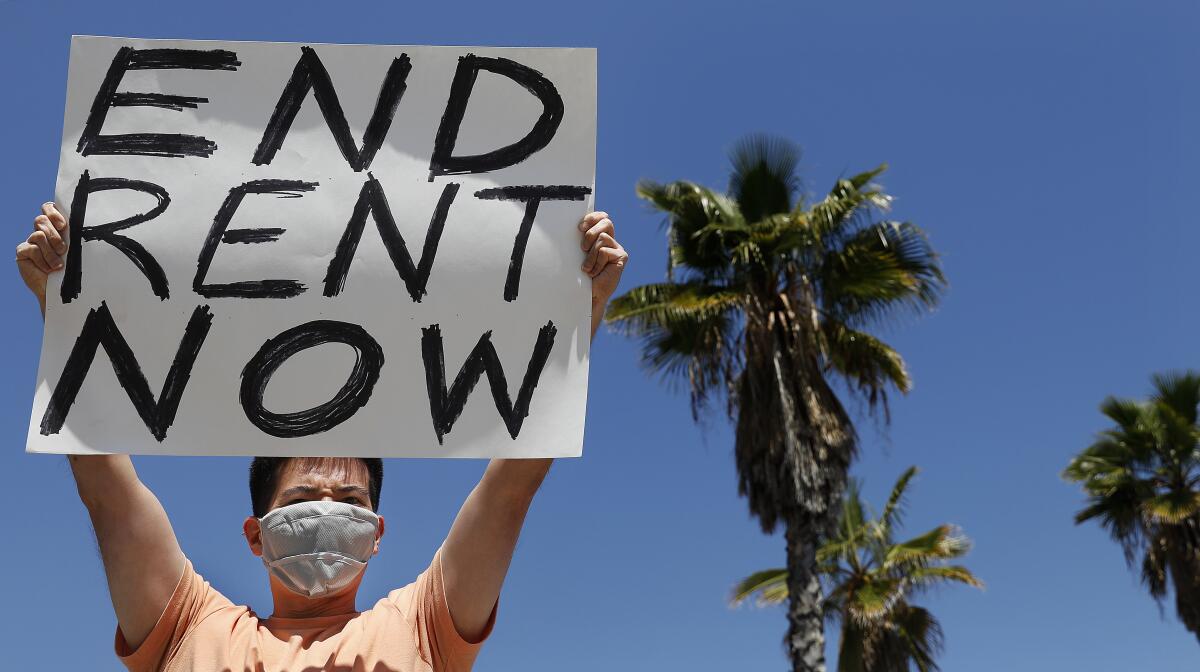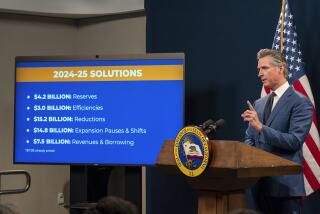California considers unprecedented $25-billion economy recovery fund, rental relief

- Share via
SACRAMENTO — Two unprecedented proposals to help Californians weather the fiscal storm unleashed by the coronavirus crisis are expected to be unveiled Tuesday by Democrats in the state Senate — one to help struggling renters, the other to create a $25-billion economic recovery fund by issuing long-term vouchers to those willing to prepay their future state income taxes.
Taken together, the ideas suggest lawmakers are willing to launch never-before-tried experiments to avoid the unpaid debts and deep cuts to government services that resulted from the Great Recession more than a decade ago.
“We need some short-term assistance,” said Senate President Pro Tem Toni Atkins (D-San Diego) in an interview with The Times on Monday. “But we’ve got to be thinking long term on how to do this in a very strategic way.”
The proposals are scheduled to be formally unveiled Tuesday morning in Sacramento, two days before Gov. Gavin Newsom sends lawmakers a plan to erase a short-term budget deficit that could total more than $54 billion.
Neither the renter-assistance program nor the economic recovery fund would have a direct effect on the state budget in the coming weeks and months. Still, lawmakers believe both ideas could boost California’s shattered economy.
The unconventional effort to help renters would ask landlords to forgive rent payments in exchange for equally sized tax credits spread out over a 10-year period starting in 2024. The tax credits would be transferable, meaning the property owner could sell them to an outside investor and get cash immediately.
“This is a substantive proposal that protects those who are struggling to afford their rent and also keeps rental properties from going into foreclosure,” state Sen. Steven Bradford (D-Gardena) said. “This equitable strategy will keep people housed.”
Some local governments have already stepped up to address concerns about renters being evicted during the public health crisis, promoting a variety of rental assistance programs. Pending legislation at the state Capitol also seeks to prevent evictions during the coronavirus state of emergency, which was declared by Newsom in March and has no targeted end date.
The exact number of troubled renters is unclear. As of 2018, there were 17 million renters in California, and more than half of them were rent-burdened.
Under the Senate proposal, tenants would agree to reimburse the state for the rent payments and would have 10 years to do so. Some who could prove financial hardship could have the total amount forgiven — in effect, their rent would be covered by the state.
The idea will hinge on the willingness of rental property owners to cooperate, and whether they see the long-term tax break as worth the loss of short-term rental income. Atkins said she is optimistic, arguing that landlords benefit by keeping their properties occupied.
“When you have to find a new tenant, that’s not an easy process,” she said.
The economic stabilization plan crafted by Senate Democrats in response to the COVID-19 pandemic is even more ambitious. It would offer any California taxpayer, from individuals to large corporations, a chance to prepay a decade’s worth of income taxes for a slight discount. In total, the state would offer $30 billion in long-term tax credits for $25 billion in upfront cash.
In essence, it would be a cash advance on long-term state tax revenues, using the money to fund short-term economic relief programs, which could include small-business assistance and relief for local governments.
“It’s really a 21st-century New Deal,” state Sen. Bob Hertzberg (D-Van Nuys) said. “We’ve got to get money into the system.”
Taxpayers could use the vouchers to cover taxes owed in those future years or sell them sooner to investors. That could make the documents valuable to a variety of investors, said John C. Carson Jr., the president of Raymond James Financial.
“If the state were to issue such a security that could be bought and sold in the secondary market, we expect that there would be strong interest from institutions and other investors,” he said in a statement.
By accelerating the collection of tax revenues that would otherwise be paid more slowly, the program would mean less government cash for future lawmakers to spend. Senate budget staffers estimate a $3-billion-a-year decrease in available revenues from 2024 through 2033.
They do not believe the program would affect tax dollars that are constitutionally guaranteed for public schools, because the vouchers would be counted as part of annual tax proceeds when cashed in. Such a calculation could, however, direct a larger amount of actual tax revenue toward schools in those years and away from other programs.
Other key questions will need to be addressed. It’s likely that it will be easier to create the $25 billion economic recovery fund — envisioned as being collected over as much as two years — than determining which of the state’s many needs should get the help and which ones would be left out. A document provided to The Times by Senate Democrats offers an early set of suggestions, including worker retraining, expedited infrastructure projects, wildfire prevention and homelessness assistance.
Atkins insisted the priorities would be clear. “It’s got to be tied to the economy and the critical needs,” she said.
It is also unknown how the two relief proposals will play either with Newsom or in the state Assembly. To have an immediate effect, both will have to be considered alongside a budget deficit plan that must be approved by the Legislature no later than June 15. Democrats hold a supermajority of seats in both houses and could, in theory, approve both plans without Republican votes.
For those legislators who were in office during the last recession or whose service began in its immediate aftermath, the idea of thinking outside the conventional world of government might hold a special appeal.
“You have to think differently,” Atkins said. “You have to rethink, reshape and be willing to adjust and consider new options, because the world is different. The world has been upended.”
More to Read
Sign up for Essential California
The most important California stories and recommendations in your inbox every morning.
You may occasionally receive promotional content from the Los Angeles Times.











